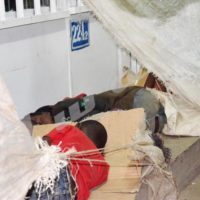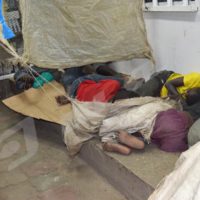A National strategy for fighting against street children phenomenon in Burundi has been elaborated by some associations and the government has adopted it to eradicate that threat.-By Diane Uwimana

Aimable Barandagiye: “Before this national strategy, street children gave up this bad behaviour only thanks to different associations engaged in eradicating the phenomenon. But now, the government will also contribute in this struggle”.©Iwacu
The Ministers’ Council has finally adopted the national strategy this 23rd January2014. This strategy has the main objectives of preventing or reducing the phenomenon and protecting street children. By the end of 2016, duty bearers will have to set up a major strategy in order to reduce the exodus of children into the street; youths and adults in street situation will be integrated in order to fight against the phenomenon. Furthermore, in each area, there will be a protection center to help the street children. It will belong to decision-makers to appreciate the situation and the phenomenon will probably be reduced progressively. Finally, 60 % of those street children will be reintegrated in their families and communities. It is worth reminding that up to now, street children constitute a big number in different provinces. According to the recent identification conducted by Associations’ National Federation for Children in Burundi “FENADEB- Fédération Nationale des Associations Engagées dans le Domaine de l’Enfance au Burundi”, 2661 street children are in Bujumbura City Council, 401 in Ngozi, 191 in Gitega and 320 in Kayanza. According to Aimable Barandagiye, the Chairman of FENADEB and Project Author of the national strategy, this latter comes to help the associations find solutions to defend the children’s rights and protection. “Before this national strategy, street children gave up this bad behaviour only thanks to different associations engaged in eradicating the phenomenon. But now, the government will also contribute in this struggle,” says Barandagiye.
Three strategic approaches to achieve the goal
Aimable Barandagiye states that three strategic approaches including prevention, response plus support and coordination will be used for a successful achievement.
For the first strategic approach, Barandagiye notes that prevention will include three components. “We will focus on economic side to help vulnerable families in order to maintain their children at school. Not only will we deal with that fact, but also, we will tackle the socio-educative and re-creative activities, community protection, sensitization and we will run a strong advocacy in order to promote and encourage decentralization of centres of families’ development”, explains Barandagiye. The second approach deals with three parts: to begin with approaching children in the street. This consists of accompanying street children through identification and socio-educative activities, supervising drop in and taking care of them, followed by transitional taking in charge which consists of supervising street children in drop in or in temporary accommodation, thus, ending in reintegration and follow-up in their community. The third approach includes the coordination with three lines of intervention. Barandagiye mentions that it is about harmonizing the interventions in favour of street children by the Ministry of National Solidarity, Human Rights and Gender, the government ownership and all national strategic actors will work together to create a coordination network in each commune of the country and build capacity by mobilizing resources, funds and equipment for the success of the national strategy to eradicate the phenomenon in the whole country. For Aimable Barandagiye, as the Ministers’ Council has already adopted the national strategy, the government should now begin to collect resources and funds to work with the associations defending the children’s rights and protection.



















 IWACU Open Data
IWACU Open Data

